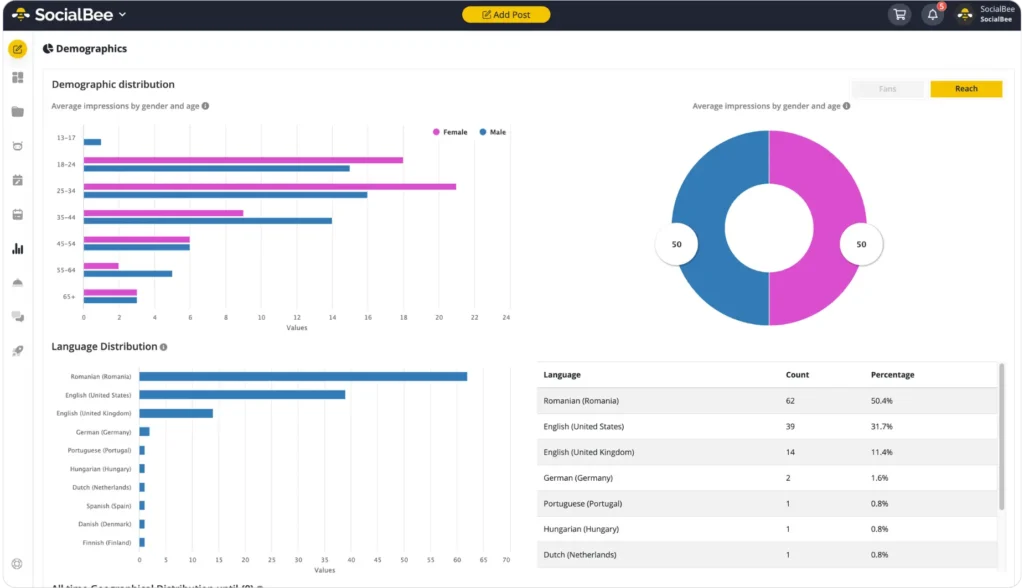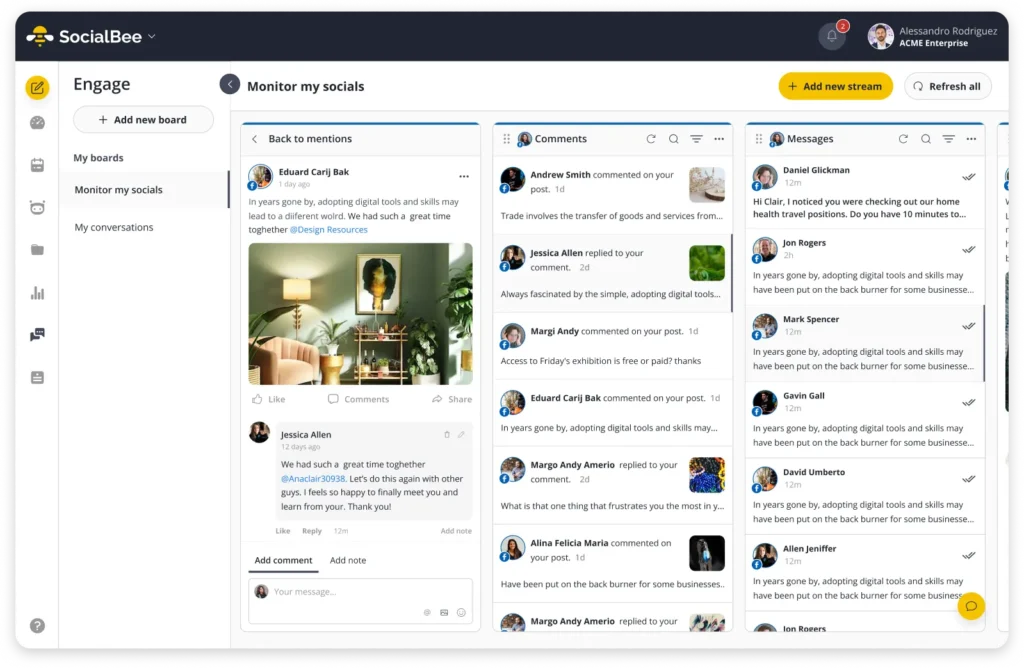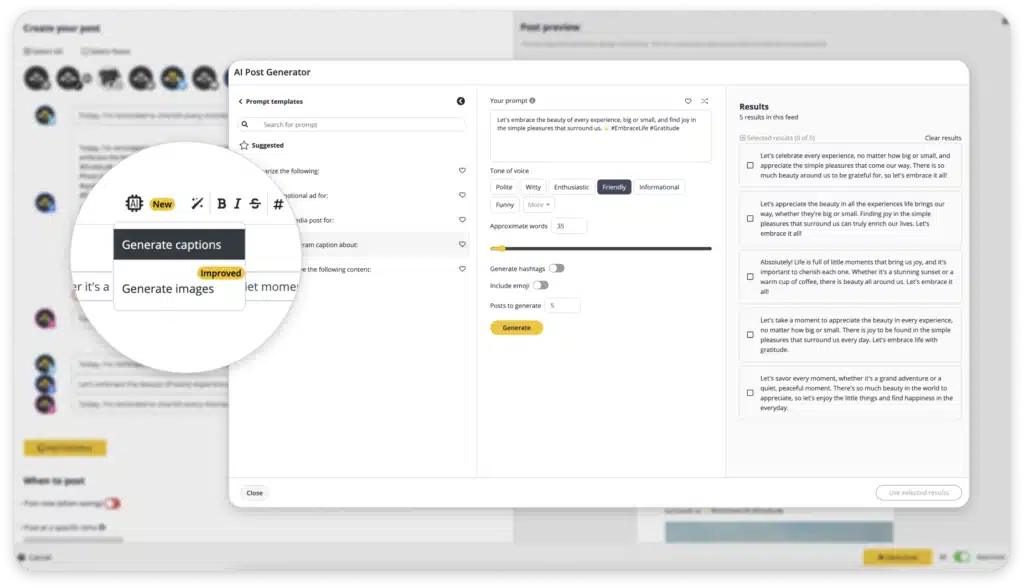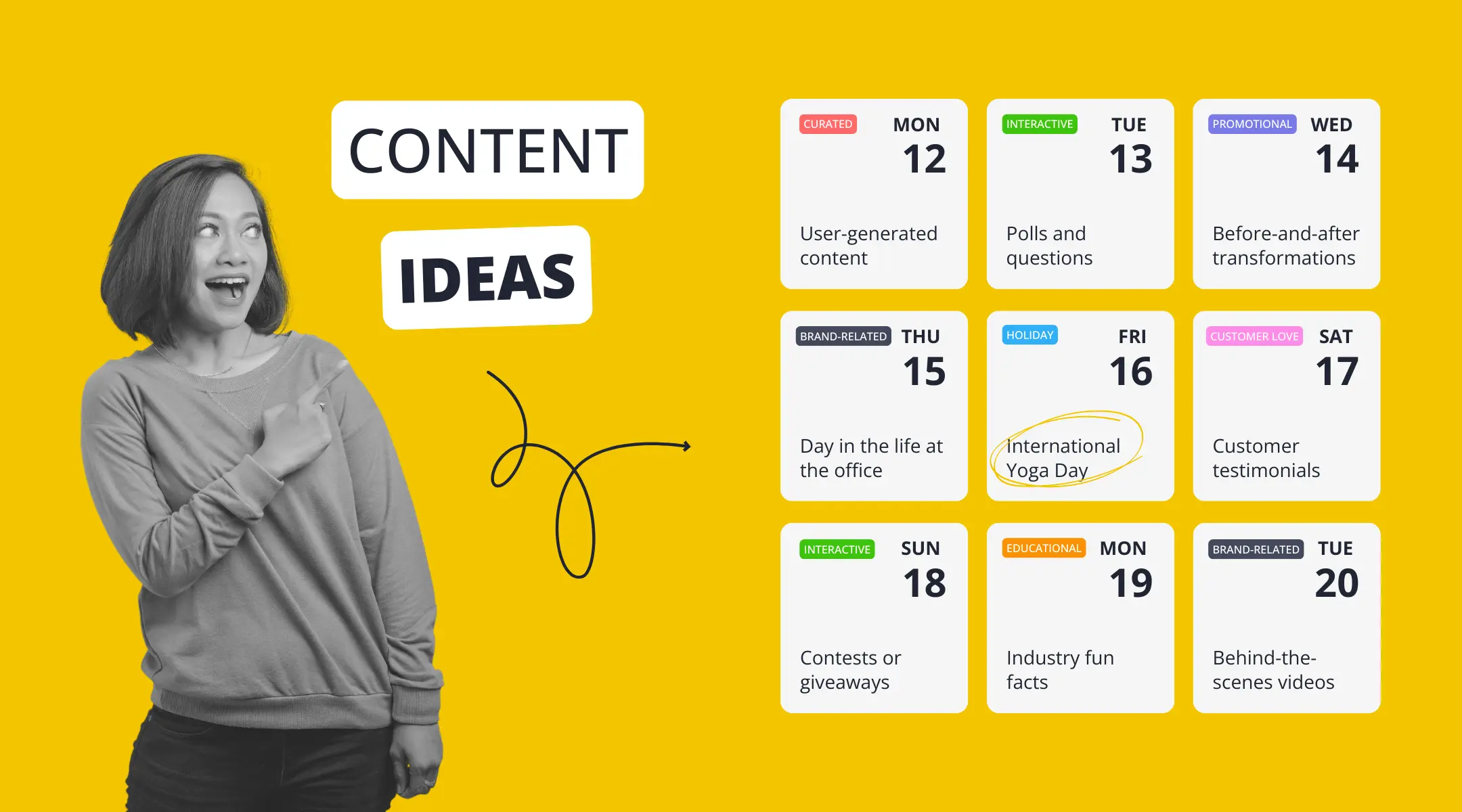Guest Author
Having a customer experience strategy is all about turning clients into loyal brand advocates who seek out your product and/or service repeatedly.
And social media can help you do this, as customers are often active on social media, sharing their opinions and experiences with others.
You can use social media to grab their attention, build relationships, and promote your brand to just the right people at the right time.
So, in this blog post, we explore what a customer experience strategy is, why social media is that key element to an awesome customer experience strategy, and how you to build one by keeping social media at its core.
Let’s begin!
Short Summary
- A customer experience (CX) strategy helps you consistently provide a great customer experience across all touch-points instead of bagging impressive one-off interactions here and there.
- Integrating social media into your customer experience strategy allows you to win customers by providing top-notch and quick, real-time customer service.
- To offer a grade-A customer experience, you need to first understand their throbbing pain points and their motivations to purchase from you.
- Empathy is key to converting frustrated customers into brand advocates.
- The customer’s perception of your brand matters the most. Actively gather their opinions on your customer service via incentivized feedback methods such as contests and giveaways.
Table of Contents
What Is a Customer Experience (CX) Strategy?
A customer experience strategy outlines how a company aims to provide a positive and consistent experience to its customers.
From initial awareness and consideration through purchase, post-purchase support, and beyond, all customer touchpoints are included.
At its core, a customer experience strategy has the following goals:
- To minimize customer efforts
- To create a seamless process
- To drive emotional connection
- To enhance customer loyalty and advocacy
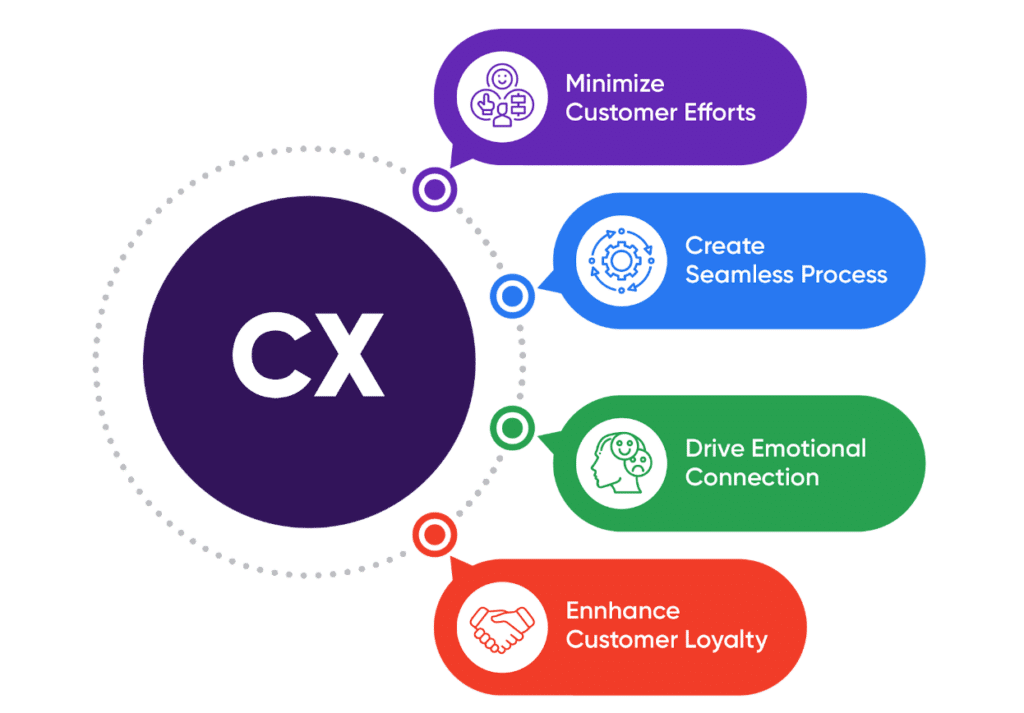
The primary goal of crafting a customer experience strategy is to create a seamless, satisfying, and memorable experience that can help you serve your customers so well that they automatically become your brand advocates.
Why Is Social Media Important In A Customer Experience Strategy?
Much like a piece of customer experience management software, social media plays an indispensable role in crafting a solid CX strategy for several reasons:
- Customer Engagement: Social media platforms provide a direct channel for companies to engage with their customers in real-time. Customers can raise queries, provide you feedback, and share their product or brand experience(s), and you can respond promptly. Additionally, leveraging a robust CX platform can further streamline customer interactions across various social media channels, ensuring a unified and efficient approach to managing customer experiences.
- Customer Support: Most customers jump straight to social media, especially Twitter, to get support instead of raising an email ticket to the customer support team. Offering customer service through social channels allows you to address issues quickly and publicly, demonstrating how much you value top-notch customer care. It also provides you with an opportunity to resolve problems before they escalate.
- Personalization: Understanding a customer’s likes and dislikes from their social media activity can help you recommend products or services that are a good fit for them. Personalization of product recommendations is key because it can lead to higher conversion rates.
- Real-Time Updates: If you run an eCommerce store, social media allows you to share real-time updates about product launches, events, and important announcements. This keeps your customers informed and engaged, and it can drive direct sales and active (and somewhat intimate) participation.
- Crisis Management: In the event of a crisis or negative publicity, social media provides a platform for you to communicate transparently and manage your reputation. Timely and honest responses can mitigate damage and rebuild trust.
How to Build A Customer Experience Strategy
Now that all the benefits of using social media from start to finish to service your customers are laid out, it’s time for us to explore how to build a customer experience strategy.
These are the steps you need to follow:
- Perform consumer research
- Map your customer’s journey
- Train customer service staff
- Determine customer expectations
- Collect feedback
1. Consumer Research
No marketing strategy can save even the best products if they don’t solve actual customer problems first.
So, to begin with, you need to figure out the social media platform where your target audience spends the most time. Make this choice using a decision tree that factors in demographic data, user behavior, and industry trends.
For example, if your audience is predominantly young professionals, platforms like LinkedIn or Instagram might be more suitable than Facebook. Thankfully, SocialBee can be your go-to tool when analyzing your audience’s demographic, allowing you to shape a loyal customer base.
Find out your social media audience demographics with SocialBee.
Start your 14-day free trial today!
Go beyond demographics and get deep into the interests, behaviors, and pain points of your ideal customers. Use audience analytics and social listening tools to gain insights into what topics and content resonate with them, and more importantly, why.
Study your competitors’ social media presence. For best customer relationship management, try to understand why your prospects rave about a competitor(s). Is it their witty Insta content or real-time customer support on Twitter, and so on? Deconstruct your competitor’s best game to understand your ideal customers well.
2. Map Your Customer Journey
A customer journey map outlines the way customers are going to travel through your marketing funnel. This gives you a pretty good estimate of how they’ll behave at each touchpoint.
That’s why, in your customer journey map, pinpoint the key interactions customers have with your brand on social media. These touchpoints might include content discovery, engagement, customer service inquiries, and post-purchase feedback.
When crafting your own customer experience management system, understand the emotions and experiences associated with each touchpoint. For instance, a customer who reaches out for support on social media may be frustrated or in need of urgent assistance, while someone who interacts with your content may be seeking inspiration or information.
And here’s the kicker and you cannot miss this:
Ensure that the social media touchpoints integrate seamlessly with other elements in the overall customer journey. Consistency in messaging, branding, and service quality is crucial.
Experimenting with different kinds of messaging is a vital process to determine what works with your audience and what does not. Make A/B testing a habit when it comes to refining your customer journey.
3. Train Customer Service Staff
You can have all the right customer service systems in place, but if the frontline service soldiers (customer service reps) don’t know how to deal with your customers correctly, you’ll always end up disappointing them.
These are some tips for training effective customer service teams:
- Develop clear guidelines and best practices for customer service provided via your social media accounts. This should include details on response times (e.g., respond within X hours), the tone of communication (e.g., polite, empathetic, and professional), and issue resolution procedures. Specify when to take conversations private (via DM’s) to address sensitive customer issues.
- Emphasize the importance of empathy and effective communication while dealing with customer issues. Train your staff to put themselves in the customer’s shoes and respond with understanding and compassion. Encourage active listening skills to fully grasp the customer’s problem before offering a solution.
- Integrate your social media with the rest of the customer support channels. Many customers come to social media after they have exhausted all their other options talking to your reps on your business phone line or email. Make sure your social media staff can pull in all the details related to the complaint right away in order to serve your customers better.
- Since social media is nothing but a public forum, your responses should be professional and empathetic. Doing just this thing well, will instantly set you apart from the crowd of companies in your niche.
- Train your team to handle potential crises on social media with poise and transparency. A well-prepared team can turn a crisis into an opportunity to demonstrate exceptional customer service.
4. Determine Customer Expectations
The secret to captivating your customers: anticipate their desires and deliver even before they express them.
To be able to create memorable customer experiences, follow these tips to understand their expectations:
- Configure your chosen social listening tools to track mentions of your brand, industry, relevant keywords, and competitors. This will help you keep an eye on conversations related to your business.
- Regularly review the data collected by your CRM to identify common themes and trends. Pay attention to recurring topics, sentiment (positive, negative, neutral), and the key issues that customers are discussing.
- Categorize the information you gather into different segments or categories. For example, you might have segments for product-related feedback, customer service issues, suggestions for improvements, and so on.
- Create feedback loops on social media by actively seeking customer input and opinions. Conduct polls, surveys, and ask for feedback in a way that encourages participation. You can incentivize or gamify it by getting feedback in exchange for a giveaway!
5. Collect Feedback
To continually improve your service, you need direct feedback from your customers. Only they can tell you if they’re happy with your service.
Here’s what you need to do in order to collect customer feedback:
- Establish clear channels for customers to provide feedback on social media — such as comments, DM’s, or dedicated feedback posts. Make it easy for customers to reach out and share their thoughts.
- Use social media analytics tools such as SocialBee to track engagement metrics, sentiment analysis, and trends. Measure your performance against KPIs like response time, customer satisfaction, and engagement rates.
- Actively engage with customer feedback and respond promptly. Positive feedback should be acknowledged and reinforced, while negative feedback should be addressed with empathy and a commitment to resolve issues.
Keep your CX strategy strong by promptly responding to comments, mentions, and DMs.
Start your 14-day free trial now!
By actively collecting feedback, you’ll be able to stay on top of the changing needs and desires of your customers.

Manage Your Social Media Customer Experience with SocialBee!
5 Tips for Boosting Your Customer Experience Through Social Media
A great customer experience strategy is focused on every interaction. After you craft your strategy, it’s important to also keep your customer satisfaction score as high as possible.
Here are five tips for maintaining a successful customer experience strategy on social media:
- Post regularly
- Know that social media never stops
- Establish a natural connection
- Adapt & improve
- Social issues matter
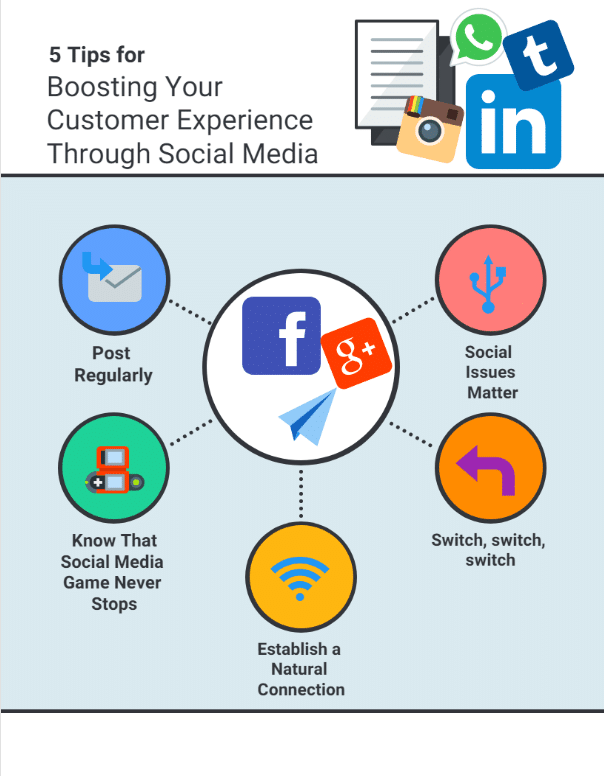
1. Post Regularly
Consistency is the cornerstone of customer loyalty. By posting regularly, you signal an active and engaged brand presence, ensuring your customers always have the latest information about your product or service.
It’s essential to strike a balance: while you don’t want to overwhelm and flood their feed, the absence can be just as detrimental.
Developing a consistent content calendar aids in this balance. A well-structured content timeline ensures that you not only deliver great content but also keep your audience anticipating your next update.
Here are some content types that can foster community engagement:
- Q&A sessions: Hosting live Q&A sessions where you answer questions from your audience in real-time can create a direct connection.
- User-generated content (UGC): Encouraging followers to create and share content related to your brand or a specific theme. Share these on your platform to acknowledge and celebrate your community.
- Tutorials and how-tos: Creating content that educates or shows your community how to use your product/service or provides value in related areas.
- Behind-the-scenes (BTS): Showcasing the inner workings of your company or the making of a product/service to make the audience feel more connected.
- Polls and surveys: Engage your audience by asking for their opinions on various topics. It gives them a sense of involvement in shaping your brand or product.
- Challenges and contests: Create fun and interactive challenges or contests with incentives. This not only boosts engagement but can also increase your reach as participants share content.
- Testimonials and stories: Sharing stories of satisfied customers or impactful anecdotes that resonate emotionally with your audience.
- Discussion threads: Starting a topic of discussion and allowing your community to chime in. This fosters interaction among community members themselves.
- Webinars and workshops: Offering free or exclusive webinars and workshops on relevant topics can draw in and engage a community interested in learning and interaction.
- Infographics: Visual content that presents information in an easily digestible format, often leading to shares and discussions.
- Interactive content: Quizzes, puzzles, or games that relate to your brand or industry can keep your community engaged and entertained.
How to Maintain Social Media Consistency with Ease
While the importance of consistent posting is evident, managing such a regular flow can be challenging. That’s where SocialBee steps in.
As a dedicated platform designed to simplify social media content management, it ensures you maintain a steady presence without feeling overwhelmed. Plus, with its AI post generator, crafting engaging posts becomes effortless.
Get Access to 1000+ AI prompts and generate top-quality content for your social media channels with SocialBee’s AI post generator.
Start your 14-day free trial now!
The predictability and regularity of your posts can reinforce trust, driving home the message that your brand is reliable. Over time, this consistent communication can enhance customer loyalty as they come to recognize and appreciate the steady value you bring to their feeds.
2. Know That Social Media Never Stops
The dynamic nature of social media demands a 24/7 presence. With a global audience spanning various time zones and lifestyles, there’s a certainty that someone is always online, seeking engagement or answers. While it’s unrealistic and inefficient to maintain a constant manual presence, it’s crucial for brands to manage customer inquiries efficiently.
To effectively engage customers around the clock, businesses need to set clear expectations regarding their response time. This clarity ensures that customers aren’t left waiting or wondering, fostering a smoother point of contact.
Leveraging tools like chatbots or auto-responders outside of typical working hours can be a game-changer. These tools ensure that every customer, regardless of when they reach out, receives immediate acknowledgment.
Incorporating such measures into your operations demonstrates a proactive approach and forms a cornerstone of an effective customer experience strategy. A clear customer communication protocol ensures that no query goes unnoticed, reinforcing the brand’s commitment to its audience.
3. Establish a Natural Connection
Building and nurturing a genuine bond with customers is pivotal in today’s marketplace.
Instead of relying solely on automation, brands must prioritize authentic touchpoints to genuinely connect. Proper customer experience management requires a blend of best practices and genuine understanding.
Here’s a list of strategies to consider in order to establish a natural connection with your customer base:
- Authenticity Over Automation: Use customer data to ensure your communication feels personalized and relevant.
- Showcase Real People: Share behind-the-scenes content or spotlight team members to give your brand a human face.
- Customer Testimonials: Highlighting these serves a dual purpose. It’s a nod to the quality of your offerings and an acknowledgment of the value you place on customer feedback.
- Engage Personally: When customers leave comments or send messages, responding with a genuine tone can work wonders. This simple act can often exceed customer expectations, leaving a lasting positive impression.
In sum, while automation and data are invaluable, it’s the human touch that truly resonates. By intertwining the two, brands can craft a compelling narrative that’s both efficient and genuine, making customers feel both valued and understood.
4. Adapt & Improve
The digital arena of social media is in constant flux. Staying agile and responsive is crucial for brands looking to thrive in this ever-evolving environment.
Being adaptable doesn’t just mean following trends—it’s about aligning with your business goals and ensuring you resonate with your audience’s desires and needs.
Here’s a strategic approach to keep you ahead:
- Align with business goals: Ensure your social media objectives mirror the overarching goals of your business. As these evolve, recalibrate your online strategy.
- Deep dive into customer journeys: Explore how your audience interacts across different platforms. This can provide valuable insights into content preferences, engagement timings, and more.
- Stay updated on trends & algorithms: Regularly invest time in learning about the latest in the social media world. Platforms, algorithms, and audience preferences change; your strategies should too.
- Regularly reassess: Your strategy is always work in progress. Reasess your active platforms determine where you get the best engagement, content types to ensure they align with persona preferences, and engagement analytics to check if your strategies are still effective.
- Develop detailed customer personas: Understand your audience better by identifying key demographic and psychographic traits, recognizing what customers want from your brand, and adjusting content and engagement tactics for each persona.
Grab the free template, fill it out, and swiftly craft your buyer persona.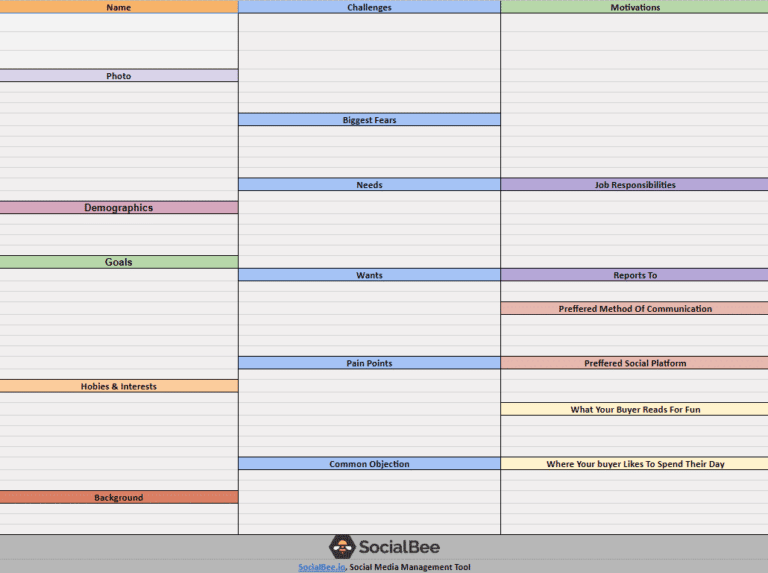
5. Social Issues Matter
Today’s customers are informed and care about global issues. It’s crucial for brands to be aware of social issues and participate in meaningful ways. This can be through sustainable business practices, charity partnerships, or simply voicing support for relevant causes. However, always ensure your involvement is genuine and not just a marketing gimmick.
Remember, a successful social media strategy is more than just gaining followers or increasing sales. It’s about creating lasting relationships with your customers.
By following these tips and always prioritizing the customer experience, you’re setting your brand up for sustained success in the digital realm.
Frequently Asked Questions
A customer experience strategy is necessary as it directly impacts a business’s success. It ensures that customers have positive interactions with the brand, so the probability of repeat business increases.
By understanding and addressing customer needs and preferences on time, a CX strategy enhances satisfaction, reducing churn and increasing revenue.
It also helps in differentiating your company in a competitive market, improving brand reputation, and driving positive word-of-mouth marketing.
Social media is important for crafting a robust customer experience strategy due to its reach of billions of people and engagement potential.
It allows businesses to directly connect with customers, gather feedback, and address concerns. Social platforms offer real-time insights into consumer preferences, enabling personalized interactions and product/service enhancements.
Effective use of social media also extends a company’s digital presence, making it easier for customers to find and engage with the brand.
Social media enhances customer satisfaction by providing immediate support, transparency, and a personalized touch. It provides a space for customers to share feedback — making them feel heard and valued.
Plus, social platforms also facilitate community building, which helps you create emotional connections with customers.
Humanizing your brand via behind-the-scenes content, employee stories, and user-generated content (UGC) makes it relatable and likable.
When people love your brand, they don’t need convincing; they eagerly want to buy from you, period.
Ready to Deliver Grade-A Customer Experience?
By actively listening to your customers on social media, providing timely responses, and delivering valuable (educational and/or entertaining) content, you can offer a customer experience that leaves nothing common between you and your competitors.
Plus, leveraging social media analytics and data-driven insights allows you to refine your strategy continually, ensuring that you’re always meeting your customers’ needs.
Having access to the best tool to manage your social media accounts eases all the seemingly mountain of work. SocialBee is precisely that – an affordable, all-in-one social media management tool that lets you schedule, create, publish posts, and analyze performance.
Start your 14-day free trial today!

Manage Your Social Media Customer Experience with SocialBee!
About the author: Anand Srinivasan is the founder of CWVIQ, an application that sends you free email alerts when your website is running slow.

